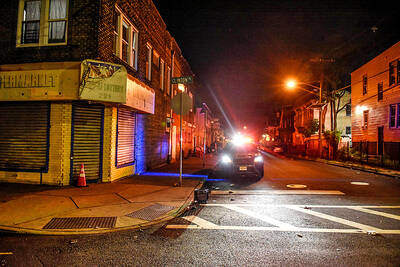Responding to a spate of fatal emergency medical helicopter accidents, a federal safety panel said on Tuesday that aviation officials were not acting quickly enough on proposals to prevent crashes.
The five-member National Transportation Safety Board in January 2006 urged the Federal Aviation Administration (FAA) to take a series of steps to improve the safety of EMS helicopter flights.
At a meeting on Tuesday, the safety board acknowledged that the FAA was working on the proposals, but not quickly enough. Over the past 11 months, nine emergency medical helicopters have crashed, killing 35 people.
The board, which has no power to force the FAA to adopt its recommendations, voted unanimously to elevate the recommendations to its annual list of top safety priorities.
FAA spokesman Les Dorr said the agency has “worked extensively and aggressively with EMS helicopter operators to improve safety and to adopt better safety procedures and technology.”
The board’s four recommendations are:
• Require EMS helicopter operators to install Terrain Awareness Warning Systems (TAWS) on helicopters. The system warns pilots when helicopters are in danger of crashing into the ground, mountains and some buildings. Safety board staff said several of the recent fatal crashes might have been prevented if the helicopters had had TAWS. They also said EMS operators could install TAWS now, but operators have told the board they’re waiting for the FAA to act.
• Require EMS flights that carry only medical personnel to follow the more stringent safety rules that apply to flights carrying patients and organs for donation. Of 55 emergency medical helicopter or plane crashes between January 2002 and January 2005, 10 crashes involved transporting medical personnel only and could have been prevented if the more stringent rules had been followed, the board said.
• Require a formal flight risk evaluation before an EMS flight.
Fifteen of the 55 crashes could have been prevented if such an evaluation had been made before takeoff, the board said.
• Require EMS flights to use formalized dispatch procedures that include up-to-date weather information and assistance in flight risk-assessment decisions.
Last month, the pilot of an EMS helicopter struggled in darkness and fog while transporting victims from a car accident in Maryland.
After the pilot radioed he was going to attempt to land, the helicopter crashed into a woody hillside in a suburban park, killing four of five occupants.
Maryland emergency officials have said that when the helicopter initially took off, there was 11km of visibility. By the time of the crash, however, conditions had deteriorated to the point that the pilot had to rely on instruments to help him land.

DOUBLE-MURDER CASE: The officer told the dispatcher he would check the locations of the callers, but instead headed to a pizzeria, remaining there for about an hour A New Jersey officer has been charged with misconduct after prosecutors said he did not quickly respond to and properly investigate reports of a shooting that turned out to be a double murder, instead allegedly stopping at an ATM and pizzeria. Franklin Township Police Sergeant Kevin Bollaro was the on-duty officer on the evening of Aug. 1, when police received 911 calls reporting gunshots and screaming in Pittstown, about 96km from Manhattan in central New Jersey, Hunterdon County Prosecutor Renee Robeson’s office said. However, rather than responding immediately, prosecutors said GPS data and surveillance video showed Bollaro drove about 3km

Tens of thousands of people on Saturday took to the streets of Spain’s eastern city of Valencia to mark the first anniversary of floods that killed 229 people and to denounce the handling of the disaster. Demonstrators, many carrying photos of the victims, called on regional government head Carlos Mazon to resign over what they said was the slow response to one of Europe’s deadliest natural disasters in decades. “People are still really angry,” said Rosa Cerros, a 42-year-old government worker who took part with her husband and two young daughters. “Why weren’t people evacuated? Its incomprehensible,” she said. Mazon’s

‘MOTHER’ OF THAILAND: In her glamorous heyday in the 1960s, former Thai queen Sirikit mingled with US presidents and superstars such as Elvis Presley The year-long funeral ceremony of former Thai queen Sirikit started yesterday, with grieving royalists set to salute the procession bringing her body to lie in state at Bangkok’s Grand Palace. Members of the royal family are venerated in Thailand, treated by many as semi-divine figures, and lavished with glowing media coverage and gold-adorned portraits hanging in public spaces and private homes nationwide. Sirikit, the mother of Thai King Vajiralongkorn and widow of the nation’s longest-reigning monarch, died late on Friday at the age of 93. Black-and-white tributes to the royal matriarch are being beamed onto towering digital advertizing billboards, on

With much pomp and circumstance, Cairo is today to inaugurate the long-awaited Grand Egyptian Museum (GEM), widely presented as the crowning jewel on authorities’ efforts to overhaul the country’s vital tourism industry. With a panoramic view of the Giza pyramids plateau, the museum houses thousands of artifacts spanning more than 5,000 years of Egyptian antiquity at a whopping cost of more than US$1 billion. More than two decades in the making, the ultra-modern museum anticipates 5 million visitors annually, with never-before-seen relics on display. In the run-up to the grand opening, Egyptian media and official statements have hailed the “historic moment,” describing the